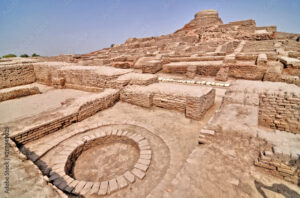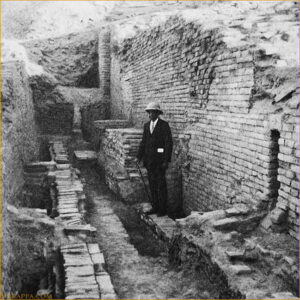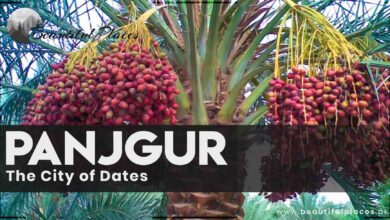The UNESCO World Heritage Site
Mohen Jo Daro (rediscovering history)

Mohan Jodaro is a word of the Sindhi language that means men’s Mound. Mohen Jo Daro was the center of the old civilization of Mehran Sindh. According to archaeological experts, this city was present in 2600 B.C and demolished in 1700 B.C due to some unknown reasons.
However, floods, the changed path of the river Indus, and earthquakes may be the reasons for its destruction. According to experts, this city was settled and destroyed seven times. Its reference is also given in the old Hindu Book “Rag o vaid”.
Moen Jo Daro’s archeological site was discovered by sir Jon Marshal in 1922. According to researchers, Moen Jo Daro was first discovered by the Indian historian R.K Bhandar in 1911. He took the overview of the things and declared this place as a sacred place for Buddhists. After one decade, Sir John Marshal started regular excavations. The car of Sir John Marshal is placed in the boundary of Moen Jo Daro.

According to the archaeological discoveries that have been made, the city has been settled on a large scale with a high degree of planning. The roads were vast and straight. Drainage was well managed while in some places drainage was underground.
About 35,000 people were living there. While constructing houses in the city, special care was taken to ensure that the structure of the building collapsed in the event of an earthquake. Near these archeological remains, a museum is located. Different things obtained in the discovery, are exhibited there. These include jewelry, weapons, sculptures, everyday things, pictures engraved on stones, and transcripts are exhibited here.
According to archeological experts, the transcripts proved that there is a link between Moen Jo Daro’s old language and the present Sindhi language. This city is included in the “World Heritage” by UNESCO (United Nations Educational, Scientific and Cultural Organization). About six years ago, an exhibition was held in Paris (capital of France) to demonstrate the remains of Moen Jo Daro.
For the promotion of tourism in Pakistan, an airport is already located in Moen Jo Daro. Now, the national airline is planning to establish a planetarium and aviation gallery. This will help in understanding the history of Moen Jo Daro and promote tourism in Pakistan.
If the tourists and researchers want to stay here, a rest house of the archeology department, PTDC hotel, Cafeteria, Handy craft shop, and other facilities are available. Pictures are also existing on ten- and twenty-rupee notes

To sum up the discussion, the Indus Valley Civilization named Mohen Jodaro is a miraculous place for researchers, philosophers, and tourists. That is the reason, it is included in the World’s Heritage. People can visit this place to see the magnificent glory of the site.
Overview Of Mohen Jodaro
| Attribute | Information |
|---|---|
| Location | Sindh Province, Pakistan |
| Designation | UNESCO World Heritage Site |
| Age | Approximately 4,500 years old |
| Civilization | Indus Valley Civilization |
| Discovery Year | 1922 |
| Excavation Status | Ongoing |
| Importance | Major urban center of ancient civilization |
| Architectural Features | Advanced city planning, intricate drainage systems |
| Notable Finds | Great Bath, Granary, Seal Impressions |
| Current Condition | Some structures preserved; ongoing preservation efforts |
Architectural Marvels
Mohenjo-daro boasts advanced architectural features that reflect a sophisticated understanding of city planning. The city’s streets were laid out in a grid pattern, and it possessed an intricate drainage system, showcasing a level of urban planning that was unparalleled in its time.
Notable Structures
Among the notable structures discovered at Mohenjo-daro, the Great Bath stands out. This large, well-designed public bath is believed to have had ritualistic and symbolic significance. The Granary, a massive structure, points to the advanced storage systems employed by the ancient residents.
Cultural Artifacts
The site has yielded a trove of cultural artifacts, including seal impressions featuring a script that is yet to be fully deciphered. These seals, often depicting animals and human-like figures, provide valuable insights into the symbolic language and trade practices of the civilization.
Challenges and Preservation
While Mohenjo-daro offers an unparalleled window into the past, it faces challenges of preservation. Environmental factors, including flooding from the nearby Indus River, and human activities threaten the structural integrity of the site. Ongoing preservation efforts aim to protect and conserve this invaluable heritage for future generations.
Famous Places in and Around Mohenjo-daro
Great Bath: A remarkable structure believed to have had ritualistic and symbolic significance, showcasing the advanced engineering skills of the ancient inhabitants.
Granary: A massive structure indicating the sophisticated storage systems employed by the ancient residents, shedding light on their agricultural practices.
Mohenjo-daro Museum: Located near the archaeological site, the museum houses a collection of artifacts unearthed during excavations, providing deeper insights into the daily life and culture of the Indus Valley Civilization.
Stupa at Mohenjo-daro: An archaeological discovery representing the Buddhist influence on the region during a later period, adding layers to the city’s historical narrative.
Culinary Delights of the Region
Sindhi Biryani
A fragrant and flavorful rice dish, often prepared with aromatic spices, tender meat, and sometimes potatoes, reflecting the local culinary richness.
Sai Bhaji
A nutritious and savory dish made with spinach, lentils, and various local vegetables, showcasing the traditional flavors of Sindhi cuisine.
Sindhi Karhi
A tangy and spicy yogurt-based curry, typically served with rice, providing a delicious taste of the region’s culinary heritage.
Kheer
A popular dessert made with rice, milk, and sugar, garnished with nuts and flavored with cardamom, offering a sweet conclusion to Sindhi meals.
Healthcare Facilities
Mohenjo-daro Hospital: Serving the local community, this hospital provides essential healthcare services, contributing to the well-being of residents in the region.
Larkana Medical Complex: While not directly in Mohenjo-daro, the Larkana Medical Complex, located in the nearby city, is a significant healthcare facility offering a range of medical services.
Educational Institutions
Mohenjo-daro Model School: Catering to the educational needs of the local community, this school contributes to the intellectual development of students in the region.
Schools in Larkana: While Mohenjo-daro itself may not host extensive educational institutions, the nearby city of Larkana is home to several notable schools, fostering a culture of learning and knowledge.
Frequently Asked Questions (FAQs)
Q: What is Mohenjo-daro, and why is it significant?
A: Mohenjo-daro is an ancient archaeological site in the Sindh Province of Pakistan, representing one of the major cities of the Indus Valley Civilization. Its significance lies in its well-preserved urban planning and artifacts, providing insights into an advanced ancient civilization.
Q: What are the famous places to visit in Mohenjo-daro?
A: Key attractions include the Great Bath, Granary, Mohenjo-daro Museum, and the Stupa. These sites offer a glimpse into the advanced architecture, daily life, and cultural practices of the ancient inhabitants.
Q: What is Sindhi Biryani, and why is it famous in the region?
A: Sindhi Biryani is a flavorful rice dish prepared with aromatic spices, meat, and sometimes potatoes. It’s famous for its unique taste and is a staple in Sindhi cuisine, reflecting the rich culinary heritage of the region.
Q: Are there healthcare facilities in and around Mohenjo-daro?
A: Yes, there are healthcare facilities, including the Mohenjo-daro Hospital and the Larkana Medical Complex in the nearby city. These facilities cater to the healthcare needs of the local population.
Q: Tell us about the educational institutions in Mohenjo-daro and Larkana.
A: Mohenjo-daro has the Mohenjo-daro Model School, contributing to local education. Larkana, in proximity, hosts various schools fostering a culture of learning and knowledge.
Q: What is the significance of the Granary in Mohenjo-daro?
A: The Granary is a massive structure in Mohenjo-daro believed to be a storage facility. Its significance lies in revealing insights into the advanced storage systems and agricultural practices of the ancient inhabitants.
Q: Can visitors explore Mohenjo-daro Museum?
A: Yes, the Mohenjo-daro Museum, located near the archaeological site, houses a collection of artifacts unearthed during excavations. It offers a deeper understanding of the daily life and culture of the Indus Valley Civilization.
Q: What is the age of Mohenjo-daro, and when was it discovered?
A: Mohenjo-daro is approximately 4,500 years old, dating back to around 2600 BCE. It was discovered in 1922 by R.D. Banerji, and excavations have been ongoing since then.
Q: What challenges does Mohenjo-daro face in terms of preservation?
A: Mohenjo-daro faces preservation challenges due to environmental factors such as flooding from the Indus River and human activities. Ongoing preservation efforts aim to protect and conserve this invaluable heritage.
Q: Is there a Buddhist influence in Mohenjo-daro?
A: Yes, the presence of a Stupa at Mohenjo-daro indicates a later Buddhist influence in the region, adding layers to the city’s historical narrative.
Wind Up Lines
In the shadow of the present-day city of Larkana, Mohenjo-daro stands as a testament to the ingenuity of ancient civilizations. It invites historians, archaeologists, and curious minds alike to unravel the mysteries of a bygone era. As we explore its streets and dwellings, we bridge the gap between the past and the present, appreciating the enduring legacy of Mohenjo-daro, a cornerstone in the mosaic of human history.




